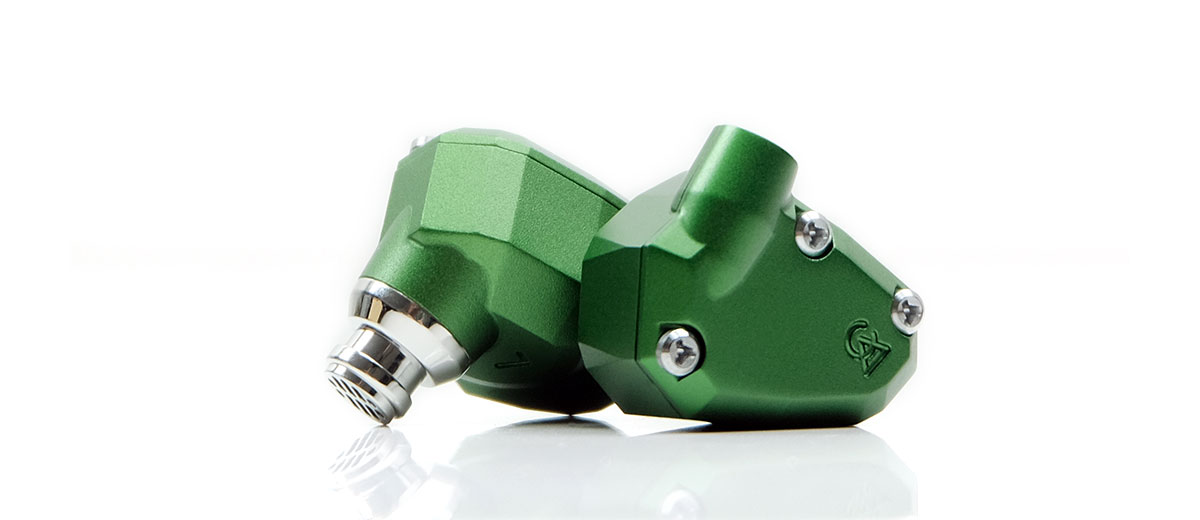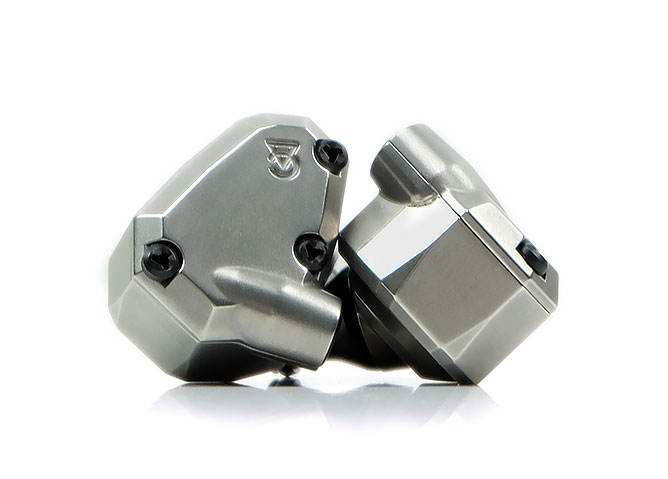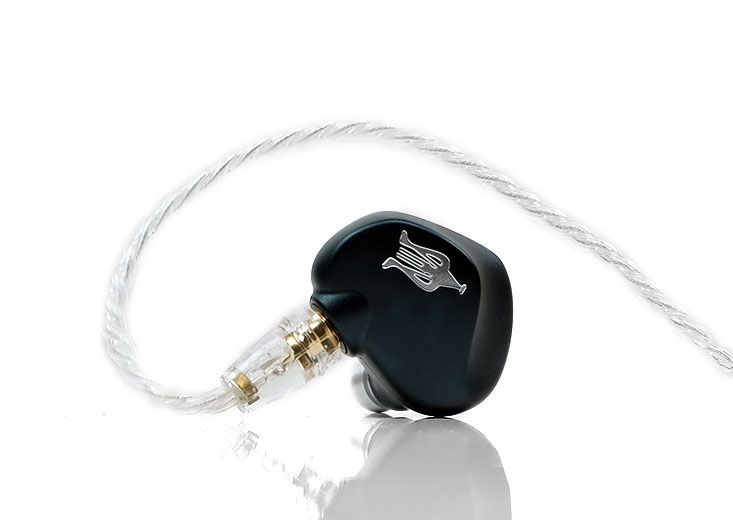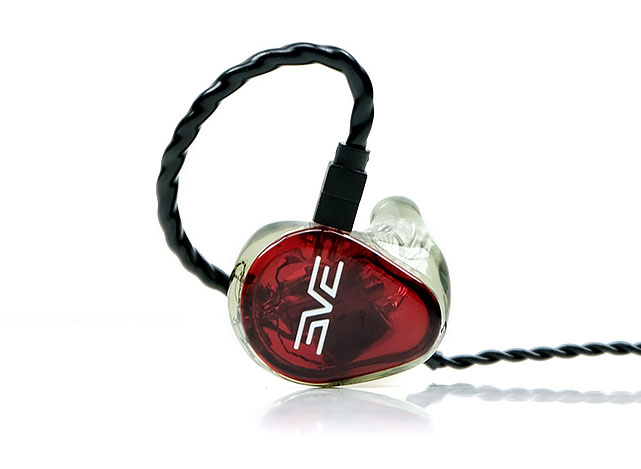Select Comparisons
Campfire Audio Ara
$1299
Technical
The Ara was one part of the trilogy of releases from CA this year, the other being the Solaris 2020 and of course the Andromeda 2020. It is pitched slightly higher than the Andromeda at $1299 but does share a lot of physical similarities.
This includes the classic edged form factor with a solid-body design, 3D printed interior as well as T.A.E.C. tubeless technology for the higher frequency driver tuning. The Ara also shared the same new MMCX design but also retains the beryllium/copper MMCX connection materials so you get the best of both worlds.
The differences? This is a 7 BA driver universal monitor as opposed to the 5 inside the Andromeda 2020.
It also uses a machined titanium shell and 3 black Torx screws adorning the faceplate instead of anodized CNC Zirconium blasted aluminum and 3 silvery screws. Both use the same 4-wire 1.35m SPC Litz with a 3.5mm TRS connection and smokey jacket.
The configuration is naturally a bit different with the Ara using one BA for the highs, one for the mids, and four for the lows. The Andromeda 2020 uses 2 for the highs, 1 for the mids, and 2 for the lows. Both use the same midrange driver as the Solaris SE.
In terms of load, the Ara is marginally more demanding at 7.094mVrms compared to 7.01Vrms but otherwise, both are quite easy to drive and both might show a bit of hiss on high noise floor amp stages.
Performance
A similarity between the two is volume. Both sit comfortably on virtually the same level on our tested DAPs; the LP P6 and the HiBy R8.
The Ara, overall, pulls your ear a little more north of 1k. Not that it lacks bass, but the mid-bass rise is milder than the fuller and punchier low-end on the Andromeda 2020.
The resulting presentation is more linear with a smooth transition into the lower mids whereas the Andromeda is weighted, more forward-sounding with a bit more of a drop into the lower mids.
To balance that out the treble on the Ara is marginally stronger than the new Andromeda 2020 treble which has a very natural but gently fade from 4-10k. The Ara has a very gentle rise in the opposite direction but nothing exaggerated or narrow in peaking that would upset the coherence.
You will hear a more forceful upper harmonic order on Ara’s notes but less so than the original Andromeda’s highs. What that means is the midrange timbre and the dominant instrumental timbre is more neutral on the Ara but not as sibilant in the upper mids.
The Andromeda 2020’s timbre is thicker than the Ara, with more sustain and a slightly wetter delivery, especially for vocals. The Ara vocals have a comparatively neutral character with less body but are a little more forward-sounding.
Vocals on the Andromeda 2020 are marginally further back when the bass kicks in but they have a more weighted and denser sound.
Overall, if you are listening to reference-sounding tracks with a more precise midrange and treble requirement then grab the Ara. If you need more low-end power, a richer midrange timbre, and a smoother high-end then the Andromeda 2020 is a better bet.
Meze Rai Penta
$1099
Technical
We covered the Rai Penta earlier this year and it does share a few superficial commonalities with the Andromeda, not least its price. However, that is where the similarities sort of end. These two are very different monitors and will appeal to different tastes.
The Rai Penta’s 5-driver configuration is a hybrid consisting of a single 10mm dynamic driver and a quad-balanced armature setup. I am presuming a 3-way crossover with the dynamic driver for the lows, 2 BA for the mids, and 2 BA for the highs.
The Andromeda 2020 uses 5 BA drivers with 2 for the highs using tubeless T.A.E.C. technology, 2 for the lows, and a mid-range BA driver.
We will not draw a direct comparison with their ratings aside from impedance which is 20Ω for the Rai Penta and 12.8Ω for the Andromeda 2020. Despite the switch to Vrms for sensitivity ratings, the Andromeda 2020 is far the easier of the two to drive.
Design
In terms of design, both use CNC aluminum but the approach is very different. Props to Meze for a beautiful design with very smooth and elegant curving on the dark blue CNC sculpted chassis.
The CNC Zirconium blasted aluminum and anodized green finish on the Andromeda is very eye-catching also though the edged finish is not quite as refined.
Both use MMCX but the Rai Penta uses the weaker standard brass V1 plates whereas the Andromeda 2020 uses the better beryllium/copper MMCX connection V2 MMC connectors.
The two also use 4-wire SPC for their cables though finished quite differently with a translucent jacket as opposed to smokey, straight-angle metal-finished dark barrels as opposed to CA’s rubbery right-angle TRS jacks.
Comfort and isolation give an edge to Andromeda 2020. The bass port of the Rai Penta means passive isolation is just so-so, even with foam tips. The Andromeda 2020 gets a little closer into the ear and has no venting ports either to produce a better seal.
Performance
Both of these monitors are aiming for the same territory, a generally u-shaped musical experience with a solid vocal presence. However, that low-end dynamic driver on the Rai Penta will create a different vibe to the dual BA of the Andromeda.
On initial impressions, the Andromeda does have a punchier or weightier bass response. The Rai Penta sounds quite controlled for a dynamic driver but where it comes into its own is the dynamic driver timbre which has a bit more nuanced detail over a longer sustain.
The Andromeda texture is a shade glossier and not quite as ‘gritty’ to bite into. It is harder hitting but smoother in sound with a shorter decay and a perception of greater speed.
From the mids onwards there are a few more differences. For instance, both have a dip in the lower mids but the Rai Penta’s is overshadowed more by its bigger 1-3k hump whereas the Andromeda 2020 1-3k rise is much gentler.
Vocals sound further forward on the Rai Penta but can dominate a bit more whereas the Andromeda 2020 sounds more integrated.
The Andromeda 2020 sounds more resolving on the technical side, assisted by what seems to be a better treble extension giving it an airier staging quality. Midrange instruments sound vibrant and articulate.
The Rai Penta isn’t veiled by any means but does not have the same airy headroom with a lower treble dip that takes a little bit of potential openness out. With less treble presence the Rai Penta timbre is natural-sounding but a bit denser and becomes more center-focused, especially when vocals come into play.
Vision Ears EVE20
€1300
Technical
The EVE20 was launched earlier this year as part of Vision Ear’s EVE series of one universal IEM being launched every year which is unique.
Inside this is also an all-BA affair like the Andromeda 2020 but using 6 drivers as opposed to 5 with a dual-vented sub, a dual full-range driver, and a dual mid/high BA driver configuration. The Andromeda uses dual drivers for the lows and highs but a single full-range driver for the mids.
The specifications for impedance are 25Ω for the EVE20 and 12.5Ω for the Andromeda 2020 though their SPL is harder to compare due to CA’s switch to Vrms whereas Vision Ears adopts the more traditional mW dB rating.
Suffice it to say both are easy to drive but fairly sensitive IEMs and both will show any hiss on high noise amplification floors.
Design
In terms of design, the EVE20 opts for a lightly contoured hollow body acrylic shell a beautiful ruby red faceplate, and an olive transparent acrylic shell underneath. It is hugely different in aesthetics and feel compared to the CNC Zirconium blasted aluminum and anodized green finish on the Andromeda 2020.
The CA design is sturdier and should take a few more knocks but the EVE20 is lighter and marginally comfier also in the ear with that smooth shell.
Neither have bass venting ports, so with the stock tips, both have a similar level of passive isolation. However, I tend to swap out the EVE20 stock SpinFit tips for Final E due to the better performance.
The cable on the EVE20 is a bit basic, a 4-wire OFC P1 Tech-style cable with a black jacket. It is nice and light but sounds a bit compressed and not quite as good as the 1.35m SPC Litz 4-wire included with the Andromeda 2020.
Performance
To my ears, these are the two closest direct competitors of the three we compared in this review. Both are going for that musical, punchy sound with good low-end heft, strong vocal presence, and clean highs. The differences are there but more nuanced than say the Ara and Rai Penta alternatives.
For a start, the EVE20 is a little more V-shaped for me. Not so much more bass but more of a sharper dip into the lower mids and greater treble presence, particularly the upper treble.
The upper treble reminds me a bit more of the older Andromeda tuning with a certain ethereal quality to its performance. Certainly, it has more dB up there than the newer smoother Andromeda 2020 treble which has a more linear top-end and a comparatively relaxed 8-10k presence.
On the low end, neither has out-and-out sub-bass dominance but the slight difference comes from that marginally shorter mid-bass sustain on the EVE20 and the earlier drop into the lower mids.
It simply does not take quite the same warmth and weight up into the mids as the Andromeda so instruments and male vocals do not sound quite as meaty on the EVE20.
The EVE20 also has a bit more shimmer and presence in percussion as well as a shade more sibilant emphasis on female vocals with that extended upper treble tuning.
The Andromeda 2020 instrumental timbre sounds more rounded to me, a little denser and heavier with its more relaxed upper treble tuning less of a factor on vocals and percussion.
Our Verdict
It is still the Andromeda only a better Andromeda. Yes, there could be an argument that it is safer less polarizing tuning with a more relaxed treble. After all, it was the tubeless treble driver that got many people talking about it in the first place.
However, the better midrange tuning, combined with a more vibrant low-end, stronger, and smoother mid-tuning and just simply more coherence throughout should win over plenty of followers both old and new.
It is still my reference for reviewing just about any source with its easy-to-drive nature and a sound signature that lends itself well to a wide range of DAPs.
The Andromeda 2020 still retains that classic status monitor for me. It is a world-class elbow dip for any audiophile who wants to get something fun to listen to.
Campfire Audio Andromeda 2020 Specifications
- 10Hz–28 kHz Frequency Response
- 94 dB SPL @ 1kHz: 7.01 mVrms
- 12.8 Ohms @ 1kHz Impedance





